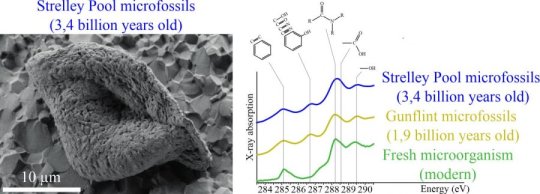[ad_1]
Scientists have confirmed that the 3.4-billion-year-old Strelley Pool microfossils had chemical characteristics similar to modern bacteria. This all but confirms their biological origin and ranks them amongst the world’s oldest microfossils. The work is presented at the Goldschmidt geochemistry conference in Boston, with simultaneous publication in the peer-reviewed journal Geochemical Perspectives Letters.
A team of scientists, led by Dr Julien Alleon (IMPMC, Paris, France; and MIT, Cambridge, MA, USA) have been able to show that the chemical residuals from ancient microfossils match those of younger bacterial fossils, and so are likely to have been laid down by early life forms.
They compared the results of synchrotron-based X-ray absorption spectroscopy analysis of the Strelley Pool microfossils with more recent ones from the Gunflint Formation (1.9 billion years old, found on the shores of Lake Superior, Ontario, Canada) and with modern bacteria. All showed similar absorption features, indicating that the residual chemicals were made from the same building blocks, thereby supporting a biological origin (see illustration below).
Dr Jullien Alleon said:
“There are a couple of important points which come out of this work. Firstly, we demonstrate that the elemental and molecular characteristics of these 3.4 Ga microfossils are consistent with biological remains, slightly degraded by fossilization processes. This effectively supports the biological origin of the Strelley Pool microfossils. There are competing claims over which microfossils are actually the world’s oldest, this analytical strategy needs to be applied to other ancient samples to help settle the controversy.
Secondly, it is remarkable that these echoes of past life have survived the extreme conditions they have experienced over the last 3.4 billion years: we know from the molecular structure of the microfossils that they have been exposed to temperatures of up to 300 °C for long periods. And yet we are still able to see signs of their original chemistry.
This is a step forward to confirming that these are indeed the oldest fossils yet discovered.”
Commenting, Professor Vickie Bennett (Australian National University) said:
“This is exciting work with the new types of analyses providing compelling evidence that the cherts contain biogenic microfossils. This is in line with other observations for early life from the Strelley Pool rocks, including stromatolites interpreted as microbial mats, and further confirming that the minimum age for life on Earth is 3.4 billion years.
The techniques used here are not applicable to the older rocks that host the claims for the oldest terrestrial life, as these rocks were exposed to much higher temperatures. These samples include the 3.7 billion year old stromatolites from Isua, Greenland and the 4.1 billion year old Canadian microfossils. However, this work shows how quickly the field is developing and that new capabilities for testing and confirming earlier evidence of life are in reach.”
Story Source:
Materials provided by Goldschmidt Conference. Note: Content may be edited for style and length.
[ad_2]















